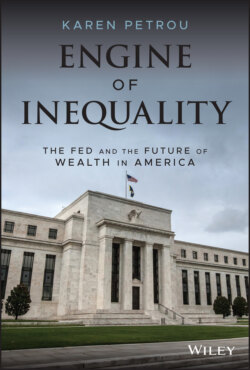Читать книгу Engine of Inequality - Karen Petrou - Страница 22
Worse Than That
ОглавлениеPresident Trump made much of unusual equality criteria – “creed” and religion – but his racial and color criteria are far more relevant to many Americans. Here, as with overall American equality, the president was mistaken. As I said, African Americans are often now worse off than before the “Great Society” of the 1960s and subsequent anti-discrimination laws presumably afforded fair and free access to financial services.36 In 2016, the average wealth of white households ($933,700) was seven times the average wealth of Black households ($138,200) and five times that of Hispanic households ($191,200).37 In 2017, Black household median income ($38,183) was less than two-thirds that of median white households, with about one-third of Black households earning less than $25,000 compared to only 18 percent of white households.38
Before COVID, only 41 percent of Black households owned their own homes, the lowest rate since the 1960s.39 White homeownership was below its highs, but still stood then at 73 percent.40
As of June 2019,41 white Americans owned 85 percent of US household wealth. That of African Americans was 4.4 percent. Hispanic wealth share was 3.2 percent, and others held 7.4 percent. To put this into context, non-Hispanic whites were only 60.4 percent of the US population at the time.42 In terms of hard cash, whites held $91 trillion; Blacks owned $4.7 trillion.
A qualitative view of racial equality comes from the Urban League, a US advocacy group. Its “Equality Index” assigns ratings based on economic and qualitative factors. In its most recent analysis,43 African Americans had an index of 72.5 percent versus the benchmark 100 granted to whites; the Hispanic index was 79.3 percent.
These inequality data are depressing enough, but they still do not show the real extent of underlying income and wealth distribution. A French scholar, François Bourguignon, has developed an interesting concept: intangible economic equality.44 He styles this the “inequality of opportunity.” This covers inequities not captured by bottom-line data because results on income and wealth may seem the same, but be substantively different due to household circumstance. For example, differences in the way a family might grow its income – getting one large pay raise versus working twice as hard – do not show up in total household labor income data. Similarly, wealth from inheritance has different market, social-welfare, and policy effects than wealth derived from one's own invention. Housing may seem available and affordable based on aggregate loan balances and costs. However, inequality occurs if the home is purchased in an undesirable neighborhood with poor schools or at a significant distance from the place of employment. As I will show later on, the Federal Reserve and US bank regulators often rely on averages or bottom-line totals to assess policy results, a methodology that masks unintended effects on shared prosperity in the glow of how well the overall system seems to be doing.
